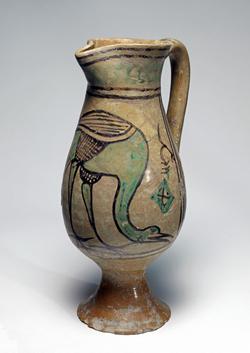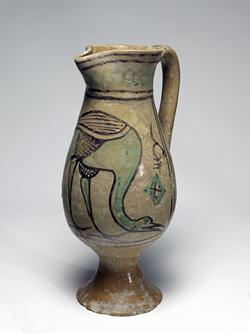Current Location: Gallery 6 (Upper Marlay): case 1, part A
Maker(s)
Pottery:
Unidentified Orvieto pottery
(Probably)
Entities
Categories
Description
Late Medieval maiolica jug, painted in manganese and green with an ostrich-like bird, bands and stripes.
Jug. Pale yellowish-buff or cream earthenware. The interior and exterior of the foot are lead-glazed brownish-yellow, the base is unglazed, and the rest is tin-glazed ivory-buff. Painted in manganese and copper-green.
Shape 17. Elongated ovoid body with short cylindrical neck which expands towards the rim and is pinched at the front to form a lip; solid pedestal foot; loop handle made from a roll of clay.
On the front, an ostrich-like bird faces to the right, its neck and head curving down towards the ground in front of its feet. Above its head, a green lozenge-shaped bloom hangs from a branch. The handle is flanked by a vertical row of curved and hooked lines between two sets of three vertical manganese lines. Above and below are two horizontal manganese bands; on the neck, a green chain with two horizontal manganese bands above; on the handle, diagonal stripes of alternate colours.
Notes
History note: Presumed excavated at Orvieto; Elia Volpi, Florence; Durlacher Brothers, London, from whom purchased in November 1920 by F. Leverton Harris (1864-1926); bequeathed by him
Legal notes
F. Leverton Harris Bequest, 1926
Measurements and weight
Height: 29.2 cm
Acquisition and important dates
Method of acquisition: Bequeathed
(1927-12)
by
Harris, Frederick Leverton
Dating
13th Century
14th Century
Medieval
Circa
1275
CE
-
1375
CE
Note
Birds of several types occur on pedestal jugs found at Orvieto and elsewhere in central Italy. They include peacocks, birds with outstretched wings, and long-legged birds bending down as if to peck.
This jug was presumably found in Orvieto as it is illustrated numbered 15. in the ninth photograph in a group believed to have been taken there c. 1909-10, given by David Whitehouse to the BM Department of Medieval and Later Antiquities.
School or Style
maiolica arcaica
People, subjects and objects depicted
Components of the work
Exterior
composed of
tin-glaze
( base unglazed)
Decoration
composed of
high-temperature colours
( manganese and copper-green)
Interior
composed of
lead-glaze
Base
Diameter 10.3 cm
Body
Width 14.4 cm
Handle To Spout
Width 16 cm
Materials used in production
Earthenware
Inscription or legends present
- Text: 8
- Location: On the base
- Method of creation: Inscribed in brownish-black
- Type: Mark
References and bibliographic entries
Related exhibitions
Identification numbers
Accession number: C.89-1927
Primary reference Number: 47307
Stable URI
Audit data
Created: Saturday 6 August 2011
Updated: Friday 16 May 2025
Last processed: Friday 16 May 2025
Associated departments & institutions
Owner or interested party:
The Fitzwilliam Museum
Associated department:
Applied Arts

 IIIF Manifest
IIIF Manifest






